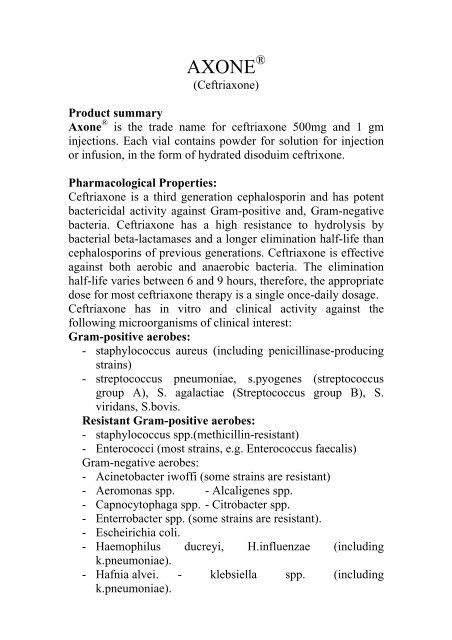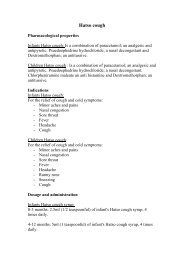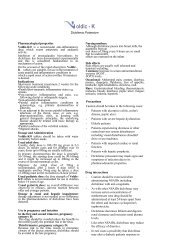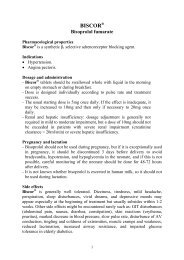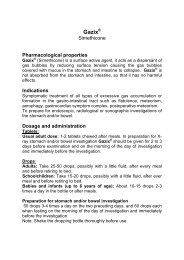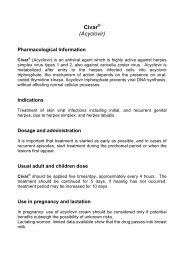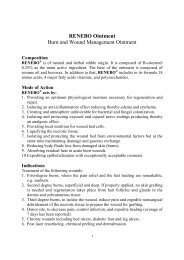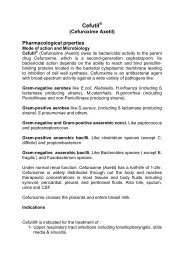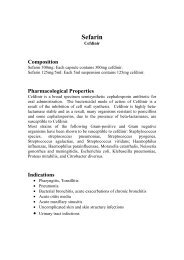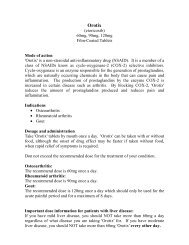Download Leaflet - Pic-jo.com
Download Leaflet - Pic-jo.com
Download Leaflet - Pic-jo.com
Create successful ePaper yourself
Turn your PDF publications into a flip-book with our unique Google optimized e-Paper software.
AXONE ®<br />
(Ceftriaxone)<br />
Product summary<br />
Axone ® is the trade name for ceftriaxone 500mg and 1 gm<br />
injections. Each vial contains powder for solution for injection<br />
or infusion, in the form of hydrated disoduim ceftrixone.<br />
Pharmacological Properties:<br />
Ceftriaxone is a third generation cephalosporin and has potent<br />
bactericidal activity against Gram-positive and, Gram-negative<br />
bacteria. Ceftriaxone has a high resistance to hydrolysis by<br />
bacterial beta-lactamases and a longer elimination half-life than<br />
cephalosporins of previous generations. Ceftriaxone is effective<br />
against both aerobic and anaerobic bacteria. The elimination<br />
half-life varies between 6 and 9 hours, therefore, the appropriate<br />
dose for most ceftriaxone therapy is a single once-daily dosage.<br />
Ceftriaxone has in vitro and clinical activity against the<br />
following microorganisms of clinical interest:<br />
Gram-positive aerobes:<br />
- staphylococcus aureus (including penicillinase-producing<br />
strains)<br />
- streptococcus pneumoniae, s.pyogenes (streptococcus<br />
group A), S. agalactiae (Streptococcus group B), S.<br />
viridans, S.bovis.<br />
Resistant Gram-positive aerobes:<br />
- staphylococcus spp.(methicillin-resistant)<br />
- Enterococci (most strains, e.g. Enterococcus faecalis)<br />
Gram-negative aerobes:<br />
- Acinetobacter iwoffi (some strains are resistant)<br />
- Aeromonas spp. - Alcaligenes spp.<br />
- Capnocytophaga spp. - Citrobacter spp.<br />
- Enterrobacter spp. (some strains are resistant).<br />
- Escheirichia coli.<br />
- Haemophilus ducreyi, H.influenzae (including<br />
k.pneumoniae).<br />
- Hafnia alvei. - klebsiella spp. (including<br />
k.pneumoniae).
- Moraxella spp. - morganella morganii (= proteus<br />
morganii).<br />
- Neisseria gonorrhoeae (including penicillinase-producing<br />
strains), N.meningitidis.<br />
- Pasteurella multocida. - plesimonas shigelloides<br />
- Proteus mirabilis, P.vugaris. - providencia spp.<br />
- Salmonella spp. (including S.typhi).<br />
- Serratia spp. (including S.marcescens).<br />
- Shigella spp. - vibrio spp. (including V.cholera).<br />
- Yersina spp. (including y.enterocolitica).<br />
Anaerobic organisms:<br />
- Clostridium spp. (except C.difficile)<br />
- Fusobacterium spp. (except F.mortiferum and F.varium)<br />
- Peptococcus spp. Peptostreptococcus spp.<br />
Therapeutic indications:<br />
Treatment of pneumonia, septicemia, bacterial meningitis,<br />
abdominal infections (peritonitis, infections of the biliary and<br />
gastrointestinal tract) ,gonorrhea, bone and <strong>jo</strong>ints infections,<br />
skin and soft tissue infections, renal and urinary tract infections.<br />
Treatment of infections in patients with impaired defense<br />
mechanisms. Prophylaxis of pre-and post-operative infections.<br />
Pharmacokinetic properties:<br />
Ceftriaxone displays non-linear concentration-dependent protein<br />
binding, mainly binding to albumin.<br />
The plasma free (unbound) fraction of the drug increased from 4<br />
to 17% over the concentration range of 500µg to 300mg/ml.<br />
Plasma Concentrations:<br />
Intravenous injection (bolus):<br />
A dosage of mg and 1.5 gm, administered intravenously as a<br />
bolus injection, results in a mean peak plasma concentration of<br />
150 and 285µ g/ml respectively.<br />
Intravenous infusion over 30minutes: after a 30-minute<br />
intravenous infusion of 500mg , 1gm or 2gm a mean peak<br />
plasma concentration of 80, 150, or 200µg/ml. respectively, was<br />
achieved.
Intramuscular injection:<br />
After 1 hour the mean peak plasma concentration after<br />
intramuscular administration was half that after intravenous<br />
administration of and equivalent dose. The AUC after 24 hours<br />
were not significantly different, therefore bioavailability after<br />
intramuscular injection is 100%.<br />
Excretion: ceftriaxone is eliminated unchanged by the kidney<br />
and the liver, with 45-60 % of an intravenous dose of 500mg to<br />
3g excreted in the urine (almost exclusively by glomerular<br />
filtration) within 24 hours. The remainder is metabolized in the<br />
intestinal tract after biliary excretion. The total plasma clearance<br />
is 0.8- 1.2 L/h, and increases with dose. The renal clearance is<br />
9.5L/h. The elimination half- life in adults is approximately 6-9<br />
hours. The half life dose not significantly with route of<br />
administration ,dose or after single or multiple doses.<br />
Pharmacokinetics in special clinical situations:<br />
The average elimination half-life is usually longer in patients<br />
over 75 year of age and in neonates, <strong>com</strong>pared to the young<br />
adult group. As with all cephaosporins, a decrease in renal<br />
function in the elderly may lead to a small but significant<br />
increase in half-life . Dosage adjustment should not be necessary<br />
in elderly patients. The elimination half –life of ceftriaxone is<br />
only slightly to moderately affected in patients with decreased<br />
renal function, increased Biliary clearance <strong>com</strong>pensates for loss<br />
of renal clearance, Patients with decreased hepatic function<br />
show an increase proportion of the drug excreted renally. Only<br />
in patients with simultaneous renal and hepatic dysfunction<br />
should the plasma concentration be monitored and the dose<br />
adjusted accordingly.<br />
Cerebrospinal fluid: Ceftriaxone can cross the meninges, a<br />
higher flux is observed across inflamed meanings <strong>com</strong>pared to<br />
non-inflamed . Concentrations attained are approximately 5% of<br />
the simultaneous plasmas concentration.
Dosage and administration : The dosage and duration of<br />
therapy depends upon the severity of the disease . Susceptibility<br />
of the causative organism, the condition of the patient and<br />
method of administration. Treatment with ceftriaxone should be<br />
continued a minimum of 48 of 72 hours after ascertaining<br />
elimination of the bacterial infection or when the patient shows<br />
no sign of fever. However, in certain indications, as specified<br />
below, a single dose will give adequate therapeutic results.<br />
Dosage: treatment may be initiated before the results of<br />
bacterial susceptibility tests are known, A once-daily dose is<br />
re<strong>com</strong>mended.<br />
Condition<br />
Adults (12 years &<br />
over)<br />
Children (under 12<br />
years)<br />
Sever renal impairment<br />
(creatinine clearance<br />
greater than 10ml/min.<br />
Pre-terminal renal<br />
impairment (creatinine<br />
clearance less than<br />
10ml/min).<br />
Hepatic impairment<br />
Renal AND hepatic<br />
impairment<br />
Dialysis patients<br />
Prophylaxis<br />
Dosage<br />
Mild to moderate Severe infection<br />
infection<br />
1 g once daily 2-4g once daily<br />
20-50mg/kg body weight<br />
once daily<br />
1g once daily provided<br />
hepatic function is normal<br />
1g once daily provided<br />
hepatic function is normal<br />
Maximum of<br />
80mg/kg body weight<br />
once daily by<br />
infusion only*<br />
1-4g once daily<br />
provided hepatic<br />
function is normal.<br />
Maximum 2g daily.<br />
1g once daily provided 2-4g once daily<br />
renal function is normal provided renal<br />
function is normal.<br />
Monitor ceftriaxone plasma concentration and<br />
adjust dose accordingly<br />
No additional supplementary dosing is required<br />
following the dialysis<br />
Surgical infection: 1g single dose colorectal<br />
surgical infection: 2g single dose in conjunction
with an antibiotic effective against anaerobic<br />
bacteria.<br />
Acute, un<strong>com</strong>plicated 250mg single dose, administered I.M without<br />
gonorrhea<br />
probenecid.<br />
*Doses above 50mg/kg body weight administered by slow I.V<br />
infusion over at least 30 minutes.<br />
Method of administration: ceftriaxone powder is reconstituted<br />
before use. The reconstituted solution may be administered in<br />
the following three ways:<br />
Intramuscular injection: reconstituted ceftriaxone must be<br />
injected into the muscles. For doses of more than 1g. divide the<br />
dose and inject at more than one site.<br />
Intravenous injection: reconstituted ceftriaxone should be<br />
administered into the vein slowly, over a period of 2-4 minutes.<br />
Intravenous infusion: reconstituted ceftriaxone should be<br />
infused slowly into a vein over a period of at least 30 minutes.<br />
Method of preparation: prepare immediately prior to use.<br />
- Intramuscular injection (500mg powder) reconstituted with<br />
1% lidocaine HCI injection** (quantity of solution 2ml).<br />
- Intramuscular injection (500mg powder) reconstituted with<br />
sterile water for injection (quantity of solution 5ml).<br />
- Intramuscular injection (1g powder) reconstituted with 1%<br />
lidocaine HCl injection** (quantity of solution 3.5ml).<br />
- Intramuscular injection (1g powder) reconstituted with sterile<br />
water for injection (quantity of solution 10ml).<br />
- Intramuscular injection (2g powder) reconstituted with sterile<br />
water for injection (quantity of solution 10ml<br />
).<br />
Intramuscular injection (2g powder) reconstituted with any of<br />
the following solutions: Glucose injection BP 5% or 0.9%<br />
Soduim Chloride injection BP, Soduim chloride and Glucose<br />
injection BP (0.45% Soduim chloride and 2.5% glucose),<br />
Dextran 6% in Glucose injection BP, or Hydroxyethyl starch 6-<br />
10% infusions (quantity of solution 40ml).
** Solutions of ceftriaxone in 1% lidocaine HCl injection<br />
should not be administered intravenously.<br />
Contraindications:<br />
Known hypersensitivity to cephalosporin antibiotics.<br />
Ceftriaxone should not be given to neonates or premature<br />
infants.<br />
Special warnings and precautions for use:<br />
Do not exceed the re<strong>com</strong>mended dosage. Care must be taken<br />
if patient has had previous hypersensitivity reactions<br />
(anaphylaxis) to non-cephalosporin beta-lactam antibiotics.<br />
Cross-allergy reactions have been reported between<br />
cephalosporins and these antibiotics. Anaphylactic shock<br />
must be treated immediately. The dosage of ceftriaxone must<br />
be reduced, as previously mentioned, if the patient has severe<br />
renal impairment as well as hepatic insufficiency.<br />
Ceftriaxone has been shown to displace bilirubin bound to<br />
serum albumin in vitro. Clinical experience has shown that<br />
this effect occurs in neonates and, therefore, ceftriaxone<br />
should not be given to neonates.<br />
Dialysis patients: ceftriaxone elimination rates in these<br />
patients may be reduced. Serum concentrations should.<br />
Therefore, be monitored to determine whether dosage<br />
adjustments are necessary. Ceftriaxone has no known effect<br />
on the ability to drive or use of machines.<br />
Interactions with other medicaments and other forms of<br />
interactions:<br />
Renal function in man is not affected after simultaneous of<br />
ceftriaxone and diuretics. Ceftriaxone does not affect the<br />
efficacy of aminoglycosides when these products are coadministered.<br />
No increase in nephrotoxixity has been<br />
observed when aminoglycsides are administered in<br />
<strong>com</strong>bination with ceftriaxone. It has been demonstrated in<br />
vitro that the actions of ceftriaxone and chloramphenicol are<br />
antagonistic.<br />
False positives to the following tests may occur in patients<br />
treated with ceftriaxone:<br />
coombs-test (rarely), Galactosaemia test.
non-enzymetic tests for glucose determination in urine.<br />
Enzymetic methods for urine-glucose determination should<br />
be utilized during treatment with ceftriaxone.<br />
Pregnancy and lactation:<br />
limited data are available on the use of ceftriaxone during<br />
pregnancy. Its safety in pregnancy has not been established.<br />
Ceftriaxone should only be used during pregnancy if<br />
essential.<br />
Minimal amounts of ceftriaxone are excreted in breast milk.<br />
Caution is therefore advised if ceftriaxone is to be<br />
administered to nursing mothers.<br />
Undesirable effects:<br />
ceftriaxone is generally well tolerated. Most side-effects are<br />
mild and transient and severe reactions have been rarely<br />
reported.<br />
The most <strong>com</strong>monly side-effects are mild gastro-intestinal<br />
<strong>com</strong>plaints, consisting of loose stool, diarrhea (very rarely<br />
pseudomembranous colitis, but must be considered), nausea<br />
and vomiting, stomatitis and glossitis.<br />
Candidiasis, or colonization with other fungi, yeast or<br />
resistant microorganisms, may also occur.<br />
Cutaneous reactions may occur, including maculopapular<br />
rash or exanthema, pruritus , urticaria, oedema, erythema<br />
multiforme and allergic dermatitis.<br />
Headache and dizziness, drug fever, shivering and transient<br />
elevation in liver function tests have been reported in a few<br />
cases. Other rarely observed adverse reactions include<br />
glycosuria, oliguria, haematurea, increase in serum creatinine,<br />
mycosis of the genital tract and anaphylactic type reactions<br />
such as bronchospasm.<br />
Heamatological reactions have included:<br />
* anaemia (all grades) - leucopenia - thrombocytopenia *<br />
neutropenia - agranulocytosis<br />
* eosinophilia - prolongation of prothrombin time *<br />
positive coombs' test .<br />
Blood counts should be monitored regularly throughout<br />
ceftriaxone therapy.<br />
High doses of ceftriaxone: calcium salt observed in urine and<br />
also as false positive gallstones in sonogram of the
gallbladder. The calcium salt is not observed once ceftriaxone<br />
therapy ceases. If symptoms are observed, conservative nonsurgical<br />
therapy is re<strong>com</strong>mended; discontinuation of<br />
treatment is at the clinician's discretion.<br />
As a rare event, local phlebitis can occur following<br />
intravenous administration with ceftriaxone. Slow<br />
intravenous injection over 2-4 minutes will help to prevent<br />
the occurrence of phlebitis. Transient and well-tolerated pain<br />
may occur at the site of injection after intramuscular<br />
administration.<br />
Overdose:<br />
In case of over dosage, haemodialysis or peritoneal dialysis<br />
will NOT reduce plasma concentrations of the drug. There is<br />
no specific antidote. The symptoms observed should be<br />
treated.<br />
In<strong>com</strong>patibilities:<br />
Do not mix Axone ® 500, or 1g, injection in the same syringe<br />
with any drug other than 1% lidocaine HCI injection (for<br />
intramuscular injection only). Ceftriaxone injection is not<br />
<strong>com</strong>patible with solutions containing calcium, there are<br />
reports within the literature that Ceftriaxone is not <strong>com</strong>patible<br />
with amikacin, van<strong>com</strong>ycin, fiuconazole or aminoglycosides.<br />
How supplied:<br />
- Axone ® (500 mg Ceftriaxone )+2ml (1% Lidocaine HCI )-<br />
Muscular Injection.<br />
- Axone ® (1g Ceftriaxone)+ 3.5ml(1% Lidocaine HCI ) for<br />
intra –Muscular Injection.<br />
- Axone ® (500 mg Ceftriaxone)+ 5ml(Sterile Water for<br />
Injection)for intra –Venous Injection.<br />
- Axone ® (1g Ceftriaxone) + 10 ml ( Sterile Water for<br />
injection ) for intra-Venous Injection.<br />
(Available in fifferent pack sizes)<br />
Storage and Stability:<br />
After reconstitution, the color of solution ranges from light<br />
yellow to to amber, depending on the length of storage,<br />
concentration and diluents used.
Axone ® solutions remain stable for the following time<br />
periods.<br />
Diluent<br />
Storage<br />
Room Temp. Refrigerated (4°<br />
(25° C) C)<br />
Intramuscular solutions 1%Lidocaine solution 24 hours 3 days<br />
Intravenous solutions Sterile water for 3 days 10 days<br />
Injection<br />
Inactive ingredient:<br />
None<br />
Storage condition:<br />
Store below 30° C


